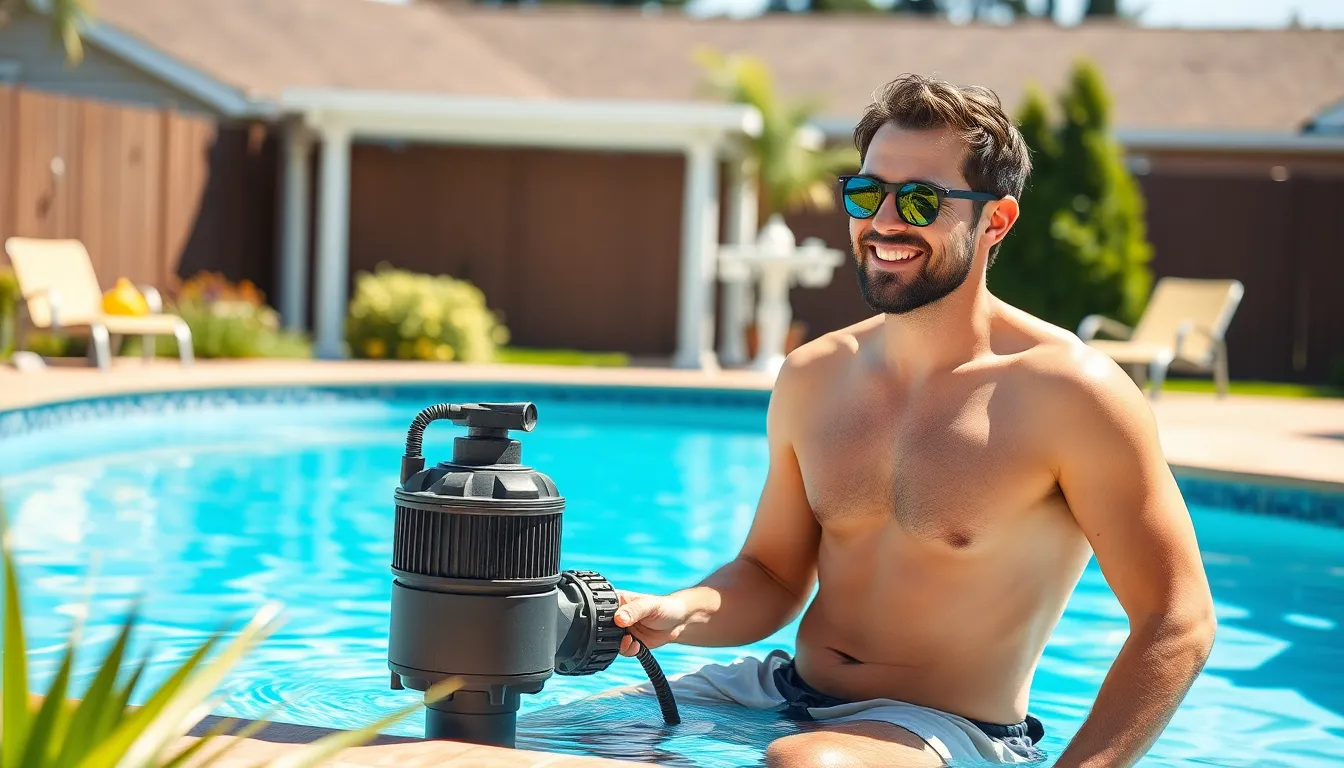If you’ve ever gazed into your pool and wondered why it looks more like a swamp than a sparkling oasis, you might be in desperate need of backwashing. While it sounds like a fancy spa treatment, backwashing is actually a crucial maintenance step for keeping your pool clean and inviting. Think of it as giving your pool filter a refreshing rinse, washing away all the gunk and grime that’s accumulated over time.
Table of Contents
ToggleWhat Is Backwashing A Pool?
Backwashing a pool involves reversing the flow of water through the filtration system. This process dislodges and expels dirt and debris accumulated in the filter media. Typically, it occurs when the filter pressure gauge indicates a rise of 8 to 10 psi above normal levels.
Pool maintenance professionals recommend backwashing every 4 to 6 weeks or after heavy usage, especially following storms. Regular backwashing helps prolong the life of the filter and keeps the pool water crystal clear.
The process begins by turning off the pump. After that, the multiport valve is set to the “backwash” position. During backwashing, water flows out of the waste line, carrying impurities away from the filter. Observing the water’s clarity provides a good indication of how much debris the filter has captured.
After a few minutes, it’s essential to switch off the pump again and position the valve back to “filter.” Then, the pump gets restarted, allowing clean water to circulate through the pool system. Following this, running the pool filter for about 1 to 2 hours ensures that fresh water returns to the pool.
Understanding backwashing is vital for pool maintenance. It enhances water circulation and filtration efficiency, making the pool safer and more enjoyable for users. In summary, backwashing not only helps maintain aesthetic appeal but also promotes overall pool health.
Importance Of Backwashing

Backwashing is essential for maintaining the cleanliness and health of a pool. This procedure keeps the filtration system functioning effectively and enhances the swimming experience.
Benefits For Pool Maintenance
Backwashing offers significant advantages for pool upkeep. It prevents the accumulation of debris, extending the life of the filter. Regularly performing this task also reduces the need for chemical treatments, as cleaner filters improve water circulation. Increased efficiency leads to lower energy costs, as the pump doesn’t work as hard. Following backwashing, a clean filter allows for better water clarity and reduced maintenance headaches.
Impact On Water Quality
Water quality greatly benefits from regular backwashing. This process removes contaminants that cloud the water, improving clarity and aesthetic appeal. When the filter operates efficiently, harmful bacteria and algae find it harder to thrive. Crystal-clear water not only enhances the swimming experience but also promotes safer conditions for swimmers. Regular backwashing contributes to balanced chemical levels, ensuring the pool water remains inviting and hygienic.
How Backwashing Works
Backwashing effectively cleans the pool filter, ensuring optimal performance. This process involves several steps to dislodge dirt and debris, maintaining a sparkling pool.
The Backwashing Process
The backwashing process begins by shutting off the pump. Next, the multiport valve is switched to the “backwash” position. Water then flows in reverse through the filter, dislodging trapped impurities. The clarity of the expelled water helps gauge the level of debris removed. After a few minutes, the pump turns off again. Returning the valve to the “filter” position allows the system to resume normal operation. Finally, running the filter for 1 to 2 hours circulates clean water throughout the pool.
Equipment Needed
Essential equipment for backwashing includes a multiport valve and a compatible pool pump. Most systems have a backwash setting to facilitate reverse flow. A pressure gauge nearby monitors the filter’s pressure levels. Additionally, a waste line directs the expelled water away from the pool area. These components work together to ensure an efficient backwashing process. Regular inspections and maintenance of this equipment help avoid operational issues during backwashing.
When To Backwash Your Pool
Backwashing a pool requires attention to specific signs and adherence to frequency recommendations to ensure effective maintenance.
Signs Indicating It’s Time
Low water clarity often signals the need for backwashing. A cloudy or dirty appearance indicates that debris has built up in the filter. Increased pressure readings on the gauge represent another strong indicator; values rising 8 to 10 psi above normal levels suggest it’s time to act. Additionally, noticing reduced water flow from the return jets points to potential blockages. Observing these signals consistently helps maintain a clean and inviting pool environment.
Frequency Recommendations
Backwashing typically occurs every 4 to 6 weeks as a general guideline. Heavy usage can accelerate the accumulation of debris, warranting more frequent backwashing during busy periods. Following storms that introduce leaves and dirt also calls for immediate backwashing. Monitoring the filter pressure gauge regularly ensures timely maintenance. Seasonal changes may also necessitate adjustments to the backwashing schedule based on specific debris types. Keeping to these recommendations helps prolong filter life and maintain water quality.
Backwashing a pool is an essential maintenance task that keeps water clean and inviting. By regularly removing dirt and debris from the filter, it ensures optimal water circulation and promotes a healthier swimming environment. Proper backwashing not only extends the life of the filtration system but also enhances water clarity and reduces chemical usage.
Monitoring pressure levels and observing water clarity are key indicators for knowing when to backwash. With a consistent schedule and attention to equipment, pool owners can enjoy a sparkling oasis throughout the swimming season. Embracing this simple yet effective process transforms pool maintenance into a straightforward routine, allowing for more enjoyable and safe swimming experiences.



